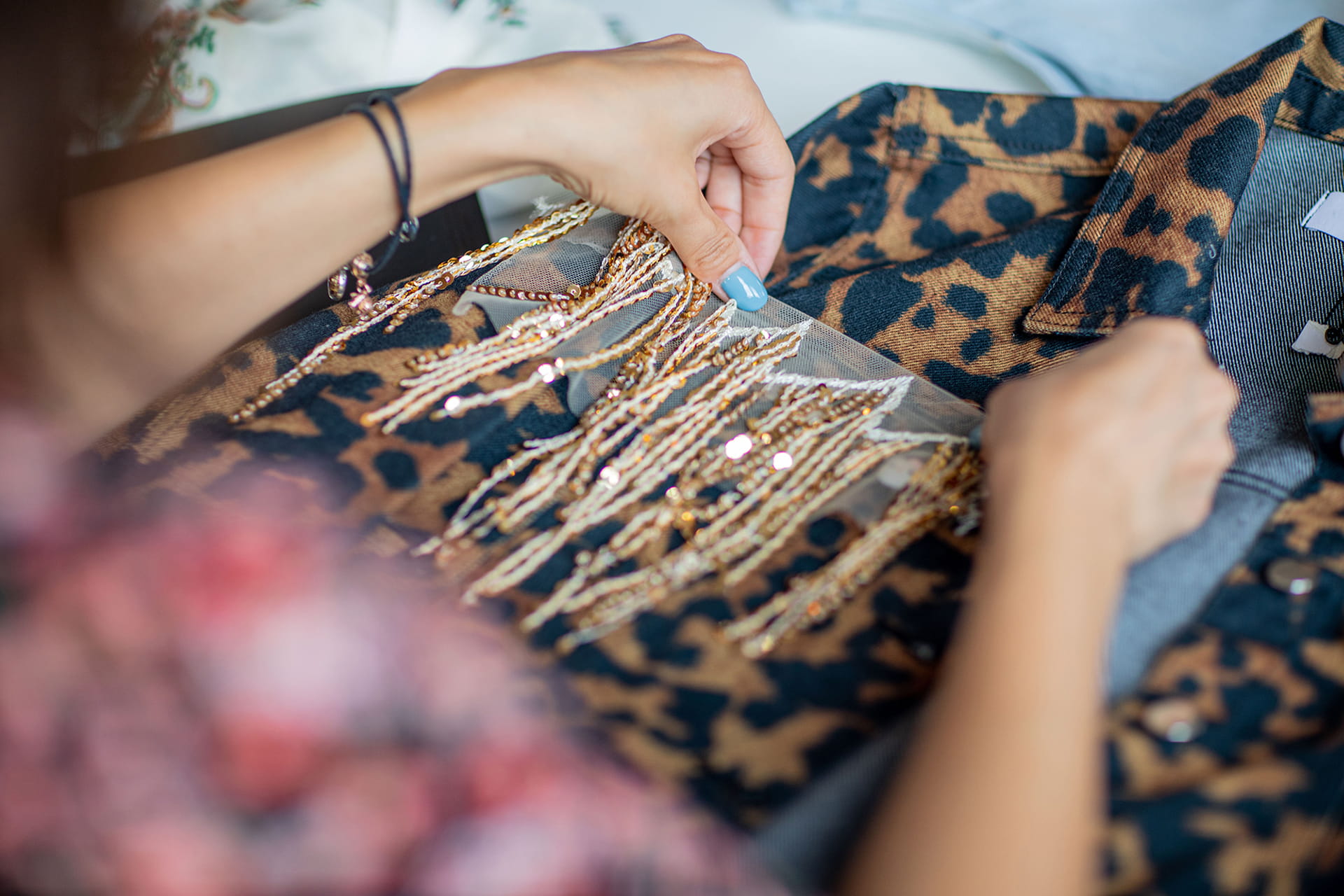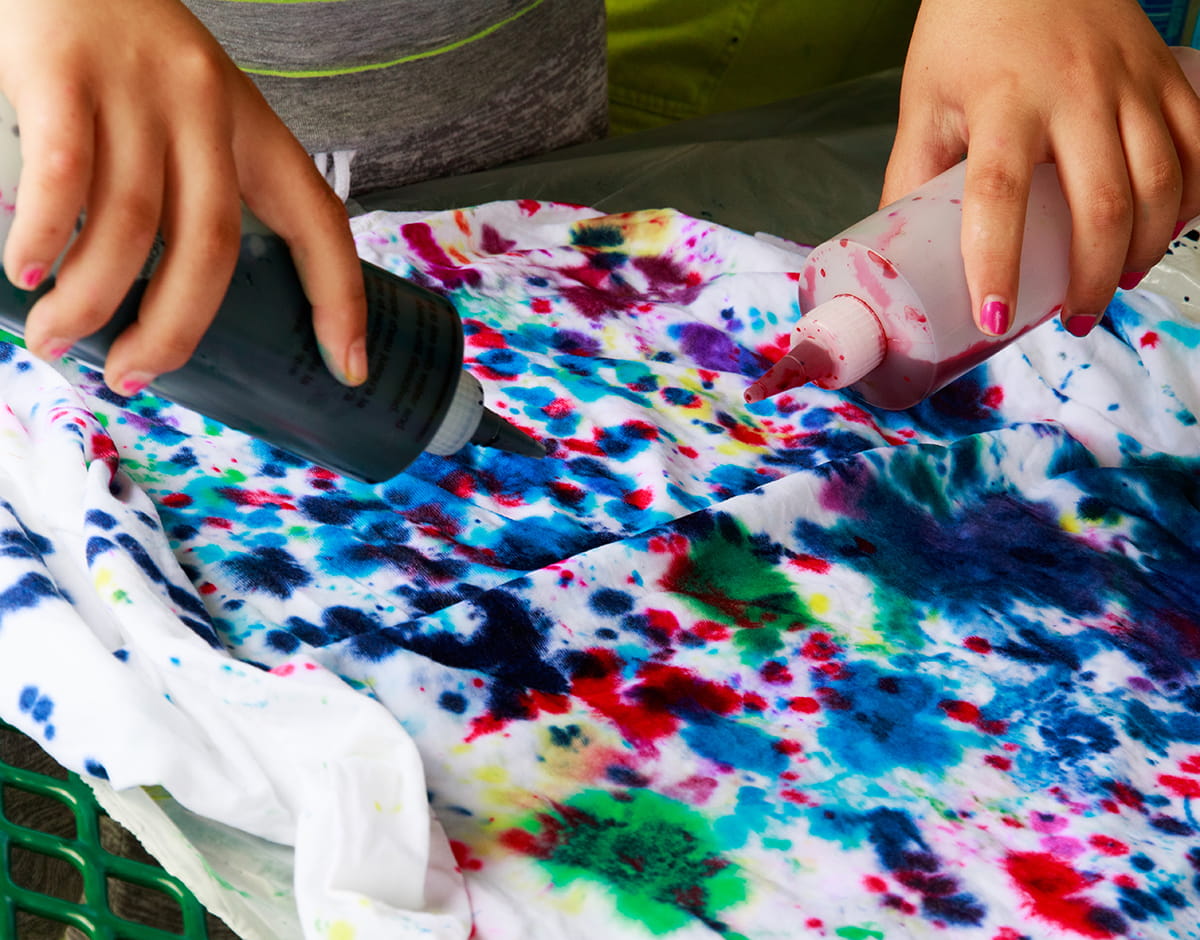Generational change
‘(…) To dress chicly is not to buy something for a lot of money that doesn’t dress us at all, but to put it together consciously: new clothes, other people’s clothes, our own clothes, second-hand clothes. Something from the wardrobe of your ancestors – that’s the fashion nowadays’ (…).
(…) An absolute frenzy of stains. Stains on different fabrics, jeans with stains and, above all, tricot shirts, T-shirts, undershirts with all sorts of stains (…). Each garment is different because it is individually dyed and you never know what will come out (…)”[1]
Barbara Hoff, the queen of creativity, was the undisputed pioneer of individualist-oriented fashion, so in her articles she not only commented on trends, but also gave advice on how to remake or change the look of clothes that we may no longer find attractive. In the pre-internet era, information was acquired in the printed press and news passed on by family, friends. It was not until generation Y, born in the millennium and referring to themselves as children of virtual reality, that they started to take advantage of the possibilities of the Internet. The tutorials and videos in the World Wide Web, which provide simple and clear information on the various garment alteration techniques, have become an invaluable resource.
Meanwhile, the older generations were fortunate that traditions of handiwork, handicrafts were often cultivated in their families. Shoes were given to cobblers, clothes were sewn or altered at tailors. Today, hardly anyone remembers that when the so-called ‘eyelet’ in a stocking broke, women used to have it repaired by ladies who knew how to catch it perfectly and patiently restore a second life to it. Stockings – an expensive and desirable product – were a luxury during the communist era, so care was taken to ensure their ‘life’.
Back to the roots
Do we need new clothes? Some people enjoy buying. However, new trends suggest a change of attitude towards fashion and thinking about what each of us can do for our planet, the Earth, to at least minimally reduce its pollution and degradation.
In some ways, redesigning clothes is a return to the roots. Reading biographies of designers active after the Second World War, I often wonder how many dresses had to be designed for women to be interested in wearing them. This is the past. The present is a world belonging to a new, mostly conscious public who no longer want to shop in supermarkets or shopping centres, even the most popular ones where well-known, fashionable brands are located. The broader design world has already recognised this trend – furniture swaps and advice on how to redecorate or refurbish have helped many people furnish their ‘nest’ anew or from scratch. Many portals offer second-hand furniture, professionals can give it a new look and even amateurs with a sense of DIY can give it a try. This trend is now widespread in fashion as well.
So maybe instead of buying another thing, it’s worth considering whether to give the ‘old’ thing a new life? Maybe it will work, maybe not, but it can’t hurt to try.
Fashionable and original
An additional benefit is a psychological, even therapeutic effect. We usually enjoy learning something new, and even after finishing school, many of us still like to learn. Handicraft techniques require patience and concentration, but this allows us to forget about the world around us for a while.
We want to look fashionable, but we don’t entertain following trends blindly. We like to look attractive and unique, but also to stand out. How? The easiest way is through clothing, styling. Branded items have already become outdated and are not in demand, unless we come across second-hand gems, even from a few decades ago. Good models, brand-guaranteed fabrics are tempting.
I encourage you to do an ‘examination of conscience’ and look through all the places where we accumulate our things. Some of them we don’t even remember, and in many cases we wonder why we ever bought them. Tidying up allows you to find clothes, often the forgotten ones.
Today, unworn clothes are given a new look. Young generations are increasingly willing to use contemporary handicraft techniques in their own way. They are interested in the past while thinking about the present. Unlike their grandparents, for whom reworking was often a necessity. For various reasons, they wanted to have something different, or things were so worn out that they were reworked for children to make them smaller. Does anyone remember that it used to be the case that clothes were ‘donated’ after older siblings? Mass production of clothes did not exist. If you wanted an overcoat, a suit or a costume, you had to get the material and go to a trusted tailor. Their addresses were guarded like the greatest secret. In his Diaries, Leopold Tyrmand describes his visits to a pre-war tailor and his discussions, which lasted for hours, about a shirt collar – the old one was out of fashion, and a new one had to be skilfully cut out of the back of the shirt. The explanation was simple – you can see the collar, but not the back of the shirt because it is covered by a jacket.

Lack of skills as an excuse
The excuses ‘I can’t, I’m unable to’ should be left on the shelf. They’re out of place. You know how to use a smartphone, you use a laptop, you use modern tools, you use all modern conveniences, you speak at least one foreign language, you travel with ease, you make transfers, you pay with BLIK and yet you can’t learn basic handicraft techniques? Don’t even admit to this ignorance, because you’ll find that your friends are not only running, working out at the gym in their spare time, but often trying to learn hand knitting. Once you get to know them, you will find that you can do them anywhere. Not just in the comfort of your home. We don’t have to know all the handicraft techniques, we can learn them by watching tutorials and videos on the internet, learn the ones we like and the results will delight us.
By the way, I have been observing with interest a new/old trend known for decades – tattoos. More and more often we meet people who decorate their bodies with various drawings, graphics, also in colour. Perhaps tattoos can be a source of inspiration? To begin with, the easiest items to make are simple signs, initials or names. Some may remember how children in kindergarten had stamps embroidered by their mothers to identify who things belonged to. I design and make my own clothes, and a friend of mine created a minimalist tag for them.
We are becoming more and more conscious, so we can afford to take an individual approach to our appearance. The internet is a modern encyclopaedia, a handbook, whatever you want to call it, and if we don’t have our own idea, we can use hints from others posted on the internet, get inspired by their ideas.
Where to start?
There are many possibilities for using the available techniques to alter clothes: patchwork, appliqué, crochet and knitting, embroidery, dyeing. A higher level of initiation is painting. Each of us is free to ‘juggle’, combine and mix them. Create your own variations.
The easiest way to start is with:
APPLICATION – this technique offers many possibilities depending on your skills. You can try the simplest way – source fabric scraps, arrange them on clothing, pin them in place and accept your design. The more skilled can arrange images. Unfortunately, this technique requires the use of a sewing machine, using simple stitches, and more skilled people with better equipped machines can use decorative stitches. With a lot of patience, it is worth trying, as in the past, to sew by hand.
Then you can move on to PATCHWORK. A handicraft technique that may be more difficult at first glance, but once you have practised a little, it turns out that the devil is not so black as he is painted. Many artists use this technique in their work, using a variety of materials. Patchwork is about combining different elements freely sourced. A jumper with two different sleeves? All right. A denim jacket with sleeves from a flannel shirt? Why not. A dress that is too short can be used as a base for a new dress with a skirt or dress bottom. There is no shortage of ideas, as long as you take the time to find inspiration and make it. After all, we often spend our time on the internet surfing various websites. How about spending that time on something useful?
EMBROIDERY is definitely more difficult. Here, we have to use cordon or floss in appropriately selected colours. Cordons are available in the form of threads rolled up on a tiny tube, floss looks beautiful in itself, when you arrange different colours next to each other, it feels softer, even silky. Equipped with thread, needles and, above all, ideas, we can proceed. The embroidery is transferred onto the target material using tracing paper. This may not be easy; it is reminiscent of painting on canvas. Again and again, we fill in the pattern on the fabric with cordon or floss, like an artist applying paint with a brush.
Speaking of paint – PAINTING is another technique we can change clothes with. We need special fabric paints and a brush. However, it is important to remember to fix the dried painting at the end. Special paints are available in popular stores found in almost every shopping centre. The advantage is that we can often see the results on samples. However, if painting does not appeal to us, we can use other techniques.
CLOTHING ENHANCED WITH BEADS – known for centuries, used in both folk costumes and the clothes of the courtly aristocracy. It is a laborious technique, but the results are impressive. Any pattern can be arranged: geometric, abstract, floral. The beads can be shiny and of different shapes. For the impatient, you can use ‘iron-on’ – buy ready-made patterns which are placed on a surface and, using a heated iron, ironed on.
Time spent in front of a laptop screen can be used helpfully and pleasantly, for example, to learn to STITCH. It is a simple technique. It starts with a so-called chain, which is the basis of the hand-knitting. On it we ‘build’ the whole pattern, and there are many possibilities. The easiest way is to start with small elements that will serve us to refresh the look of our things. You can use crochet to make accessories, bags, scarves, hats, headbands, as well as original toys for children. All you need is the right material – yarn, wool, cordon depending on what effect you want. If you manage to make smaller pieces, you can then use them to decorate your clothes – especially on jumpers and sweatshirts they work perfectly.
There are many techniques for changing the appearance of clothes, as you can see from the examples given. It all depends on us. Because we can create each thing individually, depending on our tastes and needs.
By trials and errors, you can create interesting effects, and at the same time become the lucky owner of clothes that you won’t get through general distribution channels. By wearing them, you can stand out, mark your individuality, emphasise uniqueness… Sounds interesting? Just get started. Who says you can’t be a creator who has the right to express yourself?

Author: Małgorzata Czudak, Professor at the Academy of Fine Arts in Łódź, fashion designer
Literature:
- Jolanta Dobkowska-Kubacka, Aneta Pawłowska, „Barbara Hoff królowa kreatywności”.
